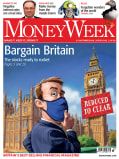The Federal Reserve is making inflation worse
In the US, prices are rising as the dollar falls and an economic slowdown is not preventing inflation. Meanwhile, Federal Reserve policy only seems to make things worse, writes Ed Bugos.
The economy doesn't know what to do with itself. The Federal Reserve has made it all but certain that inflation will be a problem. Prices are rising and everything has become more expensive.
So what ever happened to this recession we've been hearing about? Shouldn't a slowing economy be depressing prices? You'd think, but the Fed has mandated some violent economic mood swings that may spell trouble down the road.
The Bureau of Labor Statistics (BLS) reported another sharp increase in producer prices during March. Finished goods were up 1.1 percent and intermediate-level goods rose 2.3 percent, pushing the year-over-year rates to 6.9 percent and 10.6 percent, respectively, in the month of March the biggest yearly increases in this price indicator since 1981.
Subscribe to MoneyWeek
Subscribe to MoneyWeek today and get your first six magazine issues absolutely FREE

Sign up to Money Morning
Don't miss the latest investment and personal finances news, market analysis, plus money-saving tips with our free twice-daily newsletter
Don't miss the latest investment and personal finances news, market analysis, plus money-saving tips with our free twice-daily newsletter
US consumer prices rose four percent year over year, pushing the high end of a 15-year range. And you can bet the reality is worse than what the government data will confess.
The UK also reported a 6.2 percent year-over-year gain in its headline PPI. I mention it because the pound has been stronger than the greenback in recent years but the inflation story is not just about the dollar. The buildup of inflation pressures overseas will soon be evident when the foreign currency bubble pops.
You're seeing a price revolution unfold before your very eyes. Media reports of truckers and consumers angry over escalating fuel prices are becoming more frequent and intense, as are the reports of riots over soaring food prices in some corners of the world. Cost inflation continues to ravage mining project economics, hampering the industry's ability to increase production in response to higher prices.
The ultimate cause of both price inflation and the business (boom-bust) cycle lies in the constant manipulation of money supply and interest rate levels by central banks and their governments.
The economic data, meanwhile, continue to point to recession. Instead of letting the market correct the dislocation heaven forbid central bankers, under pressure from the electorate, are but fanning the flames with price pressures already at two-decade highs.
Working off the same defunct Phillips Curve dynamic (the consumptionist theory of a trade-off between inflation and unemployment) that formed the monetary policy playbook of the 70s, the Federal Reserve is hoping a weak economy will weigh down prices. Yet even using this theory, one can see that if the Fed is successful at averting recession, what will keep prices down?
There is no end in sight for this vicious cycle but hyperinflation if the policy continues.
But more relevant to the present, the idea that slower economic growth might relieve price pressures that are concomitantly fueled by monetary policy is limited by global factors that many have alluded to over the past year or two a worldwide slowdown in the growth of the real pool of savings, a switch from mercantilism to consumption policies in developing countries and slower productivity growth.
As one economist recently put it (emphasize mine):
"Past bouts of expansion have created bubbles in the financial sector, plus other sectors such as housing and state-dominated sectors like medicine and education. But a high dollar internationally, the growth of the international division of labor as well as technological advance kept the prices of consumer goods down, even falling. All these effects have been absorbed already, and the falling dollar relative to other international currencies has meant a higher price on imports. Lower productivity contributes, as well, as does the general recessionary environment. So the downward price pressure on consumer goods is at an end."
So a contraction in production just makes the situation worse.
Tell it to the Fed. Or just buy gold.
By Ed Bugos for Whiskey and Gunpowder
Sign up for MoneyWeek's newsletters
Get the latest financial news, insights and expert analysis from our award-winning MoneyWeek team, to help you understand what really matters when it comes to your finances.
-
 Should you invest in emerging markets?
Should you invest in emerging markets?Emerging markets offer strong, long-term growth and excellent value, says Rupert Hargreaves
By Rupert Hargreaves Published
-
 How to invest in frontier markets
How to invest in frontier marketsFrontier markets can be extremely risky, but they offer access to exotic stocks in rapidly developing countries
By David C. Stevenson Published